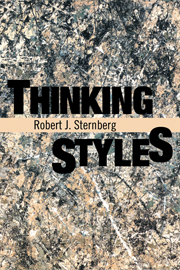Book contents
- Frontmatter
- Contents
- Preface
- Part I The Nature of Thinking Styles
- 1 What Are Thinking Styles and Why Do We Need Them?
- 2 Functions of Thinking Styles: The Legislative, Executive, and Judicial Styles
- 3 Forms of Thinking Styles: The Monarchic, Hierarchic, Oligarchic, and Anarchic Styles
- 4 Levels, Scope, and Leanings of Thinking Styles: The Global, Local, Internal, External, Liberal, and Conservative Styles
- Part II The Principles and Development of Thinking Styles
- Part III Thinking Styles in School and in Research and Theory
- Notes
- Index
4 - Levels, Scope, and Leanings of Thinking Styles: The Global, Local, Internal, External, Liberal, and Conservative Styles
Published online by Cambridge University Press: 05 August 2012
- Frontmatter
- Contents
- Preface
- Part I The Nature of Thinking Styles
- 1 What Are Thinking Styles and Why Do We Need Them?
- 2 Functions of Thinking Styles: The Legislative, Executive, and Judicial Styles
- 3 Forms of Thinking Styles: The Monarchic, Hierarchic, Oligarchic, and Anarchic Styles
- 4 Levels, Scope, and Leanings of Thinking Styles: The Global, Local, Internal, External, Liberal, and Conservative Styles
- Part II The Principles and Development of Thinking Styles
- Part III Thinking Styles in School and in Research and Theory
- Notes
- Index
Summary
Thinking styles can differ in level, scope, and leaning. Let's see what each of these means.
LEVELS OF THINKING STYLES: GLOBAL AND LOCAL STYLES
Before reading about the global and local styles, take Self-assessments 4.1 and 4.2, and then score them.
Read each of the following statements, and then rate yourself on a 1–7 scale, where each rating corresponds to how well a statement describes you: 1 = Not at all well; 2 = Not very well; 3 = Slightly well; 4 = Somewhat well; 5 = Well; 6 = Very well; and 7 = Extremely well.
— 1. I like situations or tasks in which I am not concerned with details.
— 2. I care more about the general effect than about the details of a task I have to do.
— 3. In doing a task, I like to see how what I do fits into the general picture.
— 4. I tend to emphasize the general aspect of issues or the overall effect of a project.
— 5. I like situations where I can focus on general issues, rather than on specifics.
— 6. In talking or writing down ideas, I like to show the scope and context of my ideas, that is, the general picture.
— 7. I tend to pay little attention to details.
— 8. I like working on projects that deal with general issues and not with nitty-gritty details.
Interpreting Scores
The way you evaluate your score is to add up the eight numbers you wrote down above, and then divide by 8. Carry out the division to one decimal place. You now should have a number between 1.0 and 7.0. There are six categories of scores, which depend on your status and your sex.
- Type
- Chapter
- Information
- Thinking Styles , pp. 60 - 76Publisher: Cambridge University PressPrint publication year: 1997



